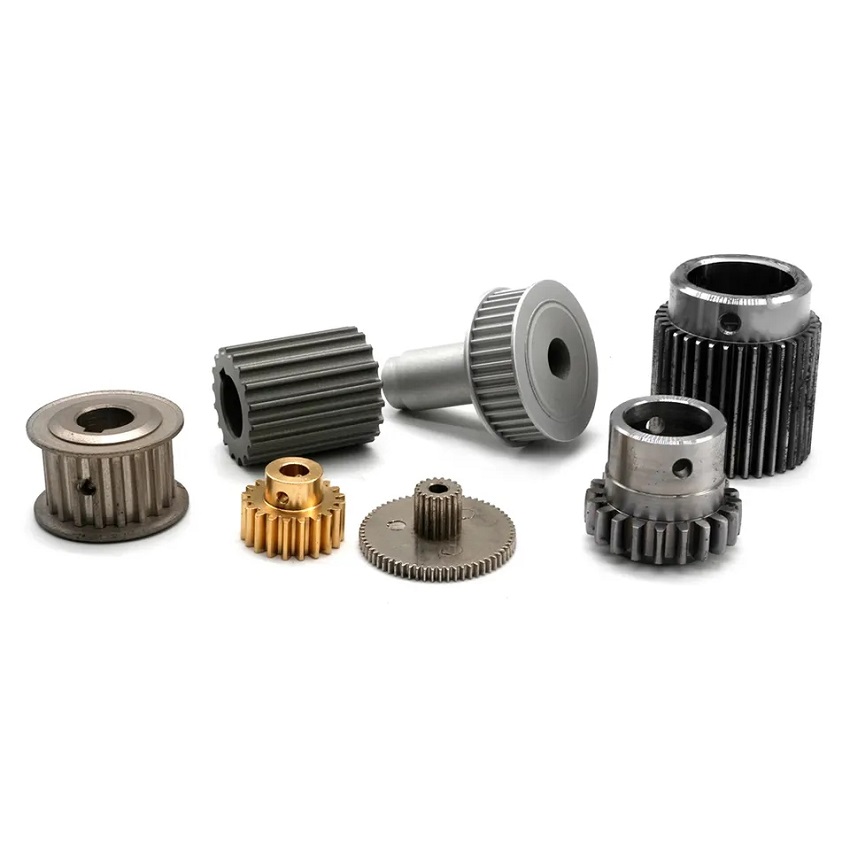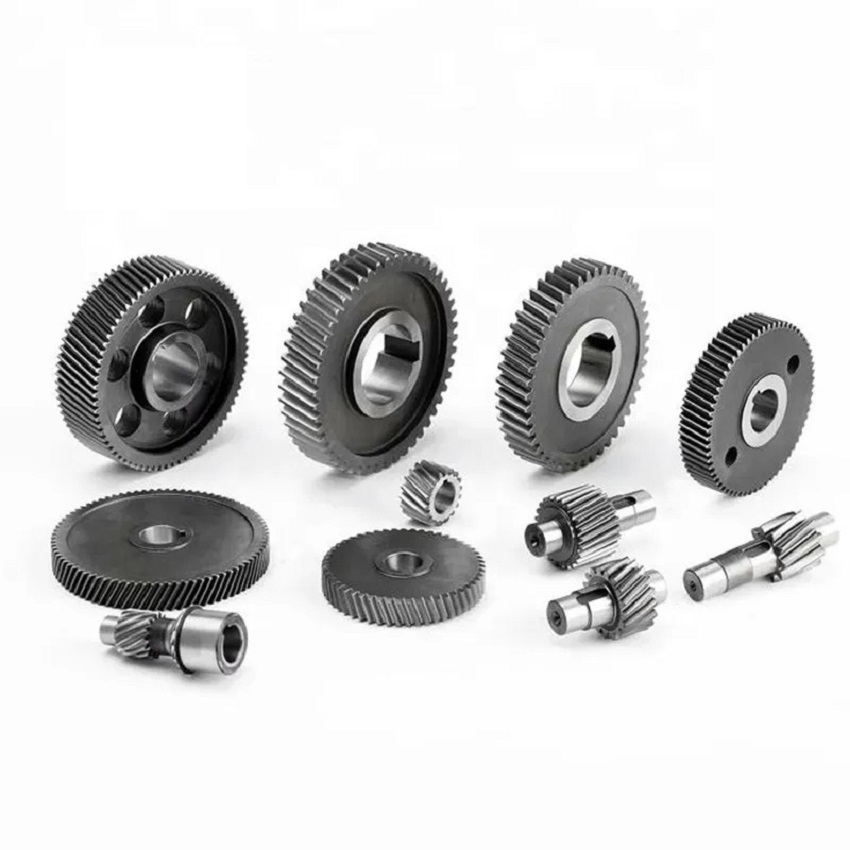Gear Materials For Powder Metallurgy
Related Resources
A gear is a mechanical device that transmits torque and motion in a direction that exerts force either parallel to the original or perpendicular to it. Straight teeth, spiral teeth, conical teeth, and other shapes of gear wheels can be used to reduce gear noise or increase the torque characteristics of the gear load. The development of customized materials and material production technologies is encouraged due to the rising demand for power density and gear wheel life.
The requirements for gear materials have increased due to the need for greater usability and better durability of gear transmission installation, which has resulted in the development of gray cast iron, ductile cast iron, malleable cast iron, and ultimately high-performance carburized low alloy steel. The tensile force produced by the typical gear wheel movement can be offset by the carburized surface of the gear wheel, which can give its surface a compression pressure.
The additional advantage of carburizing is that the pitting resistance strength can be increased, and the wear resistance can be improved due to the residual austenite stored on the gear surface. Good gear usability requires the following bonding powder metallurgy characteristics
- Material types and hot processing
- Surface hardness
- Strength and fatigue characteristics
- Gear mass

PM Gears Materials
| Materials | cupric cemented steel | nickel steel | low alloy steel | |||
| Performance | ||||||
| Typical composition | 13Cu-0.8C-Fe | 2Ni-0.5C-1.5Cu-Fe | 0.4Mn-0.5Ni-0.6Mo-0.5C-Fe | |||
| Material state | Quench and temper from 8710C | Sintered state | Quench and temper from 8710C | Sintered state | Quench and temper from 8710C | Sintered state |
| density(g/cm3) | 7.3 | 7.3 | 6.8 | 6.8 | 6.7 | 6.8 |
| ultimate tensile strength(kgf/mm2) | 80.5 | 59.5 | 66.5 | 36 | 78.4 | 35 |
| Tensile yield strength, residual deformation0.2%(KGF/mm2) | 74.9 | 40.5 | 56 | 28 | 72.1 | 29 |
| elongation (%) |
0.5 | 3 | 0.8 | 1.5 | 0.6 | 1 |
| apparent hardness | HRC 38 | HRB89 | HRC 24 | HRB65 | HRC 29 | HRB60 |
| pellet hardness | HRC58 | N/D | HRC 40 | N/D | HRC 44 | N/D |
| Impact strength (Charlton value, no notch)(kgf.m) | 0.87 | 1.4 | 1.38 | 1 | 1.24 | 0.9 |
For gears requiring higher strength, copper-permeated sintered steel can be used, with a density of 90 ~ 95% theoretical value, low connectivity porosity, and smooth operation. For gears that need to strengthen self-lubrication and increase wear resistance, thus requiring a higher oil content, the general material density is 80 to 90% theoretical density.
Due to the development of new materials and production processes, the application of powder metallurgy in the application of gear wheel transmission equipment is continuing to expand. The production process of powder metallurgy saves raw materials and can be used to produce a gear wheel driving device with a final shape. Historically, due to the inherent porosity in the powder metallurgy parts and the limitation of the metallization available in powder metallurgy materials, powder metallurgy has been limited to the application of low strength. In recent years, the development of new alloys and advanced production processes has significantly increased the degree and strength of powder metallurgy parts, so that the driven installation of powder metallurgy gear wheels can compete with the application of high-performance gear wheels.

Common gear materials
The tooth surface should be sufficiently hard and wear-resistant, the tooth core should be sufficiently tough to prevent various failures of the tooth surface, and it should have good cold and hot processing technology to meet the various technical requirements of the gear. These are the fundamental requirements for gear materials.
High-quality carbon structure steel, alloy structural steel, cast steel, cast iron, and non-metallic materials come in a variety of grades and are frequently utilized as gear materials. Forgings or rolled steel are typically used. Cast steel can be utilized in gear structures with huge sizes and difficult-to-forge wheel blanks. Gray cast iron or ductile cast iron are both suitable materials for open low-speed transmission. Low speed and high load on a gear make it simple to plastically distort the tooth surface, making the tooth breakable. Since tooth surface pitting is easily caused by high-speed gear, it is wise to choose a material with a high tooth surface hardness; gear subject to impact loads should be built of materials with good toughness. Non-metallic materials, including plywood, nylon, and so forth, may also be utilized for gear transmission that operates at high speeds with light loads and low noise. The following table includes a list of frequently used gear materials and their mechanical characteristics.
The heat treatment methods of steel gears are mainly as follows:
- Surface hardening
Surface quenching is often used for medium carbon steel and medium carbon alloy steel, such as 45, and 40Cr steel. After surface quenching, the tooth surface hardness is generally 40 ~ 55HRC. It is characterized by high resistance to fatigue pitting and gluing. Good wear resistance; Because the tooth center part is not hardened, the gear still has enough toughness to withstand a small impact load.
- Carburizing hardening
Carburizing and quenching are often used in low-carbon steel and low-carbon gold steel, such as 20, and 20Cr steel. After carburizing and quenching, the hardness of the tooth surface can reach 56 ~ 62HRC, while the heart of the gear still maintains a high toughness, the bending strength of the tooth and the contact strength of the tooth surface are high, and the wear resistance is good, which is often used for important gear transmission under impact load. After carburizing and quenching, the tooth deformation of the gear is large, and it should be grinding.
- Nitriding
Nitriding is a surface chemical heat treatment. No other heat treatment is required after nitriding, and the tooth surface hardness can reach 700 ~ 900HV. Due to the high hardness of the gear after nitriding treatment, low process temperature, and small deformation, it is suitable for internal gears and gears that are difficult to grind, often used in nitriding steel containing lead, molybdenum, aluminum, and other alloying elements, such as 38CrMoAl.
- Tempering
Tempering is generally used for medium carbon steel and medium carbon alloy keys, such as 45, 40Cr, and 35SiMn steel. The hardness of the tooth surface after the tempering treatment is generally 220 ~ 280HBS. Because the hardness is not high, the tooth finishing can be carried out after heat treatment.
- Normalizing
Normalizing can eliminate internal stress, refine grain, and improve mechanical properties and machinability. Moderate carbon steel normalizing treatment can be used for gears with low mechanical strength, and cast steel normalizing treatment can be used for gears with large diameters.
The gear can be classified as soft tooth surface gear (350HBS) and hard tooth surface gear (>350HBS) based on the hardness of the tooth surface following heat treatment. Generally speaking, soft tooth surface gears are acceptable for gear transmission. The small gear’s tooth surface hardness is typically 30 to 50 HBS higher than that of the big gear in order to decrease the likelihood of gluing and ensure that the life of the matched gears is equal. Hard tooth surface gear combinations can be used for high-speed, heavy-duty, or critical gear drives, and the tooth surface hardness can be close to the same.

Commonly used gear materials and mechanical properties
| category | material trademark | Heat treatment method | Tensile Strengthσb/MPa | yield pointσs/MPa | hardness (HBS OR HRC) |
| quality carbon steel | 35 | normalizing | 500 | 270 | 150~180HBS |
| tempering | 550 | 294 | 190~230HBS | ||
| 45 | normalizing | 588 | 294 | 169~217HBS | |
| tempering | 647 | 373 | 229~286HBS | ||
| surface hardening | 40~50HRC | ||||
| 50 | normalizing | 628 | 373 | 180~220HBS | |
| structural alloy steel | 40Cr | tempering | 700 | 500 | 240~258HBS |
| surface hardening | 48~55HRC | ||||
| 35SiMn | tempering | 750 | 450 | 217~269HBS | |
| surface hardening | 45~55HRC | ||||
| 40MnB | tempering | 735 | 490 | 241~286HBS | |
| surface hardening | 45~55HRC | ||||
| 20Cr | Carburizing hardening
after-tempering |
637 | 392 | 56~62HRC | |
| 20CrMnTi | 1079 | 834 | 56~62HRC | ||
| 38CrMnAlA | nitriding | 980 | 834 | >850HV | |
| Cast steel | ZG45 | normalizing | 580 | 320 | 156~217HBS |
| ZG55 | 650 | 350 | 169~229HBS | ||
| Grey cast steel | HT300 | 300 | 185~278HBS | ||
| HT350 | 350 | 202~304HBS | |||
| nodular cast iron | QT600-3 | 600 | 370 | 190~270HBS | |
| Qt700-2 | 700 | 420 | 225~305HBS | ||
| nonmetal | Fabroil | 100 | 25~35HBS |
JH MIM: Professionally build high-quality gears to help you open the door to success
As an enterprise with technological innovation and quality as its core competitiveness, JH MIM is committed to providing customers with high-quality, efficient powder metallurgy gear products and services. We have advanced production equipment and technology and strictly control every production link to ensure high gear precision, long life, and stable performance. No matter what type of gear you need, we can tailor it to meet your specific needs. Contact us now, send your gear inquiry, and let’s open the door to success together!
